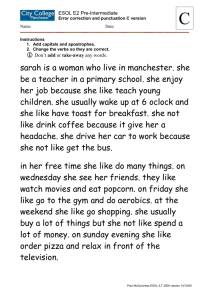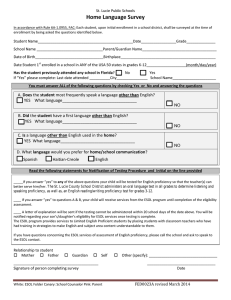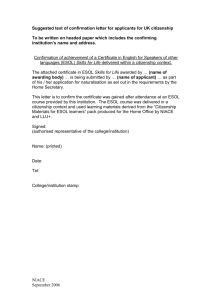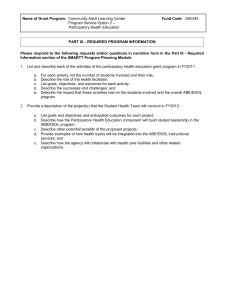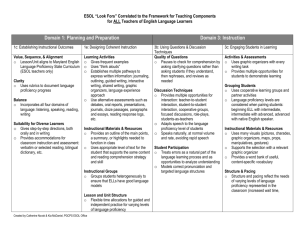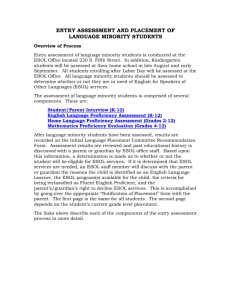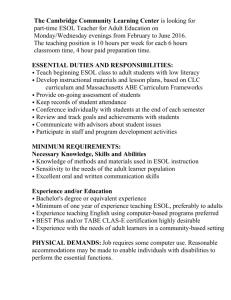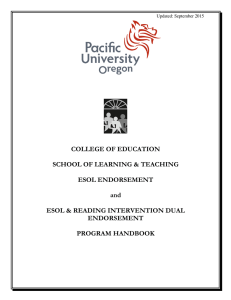Supporting English Language Learners
advertisement
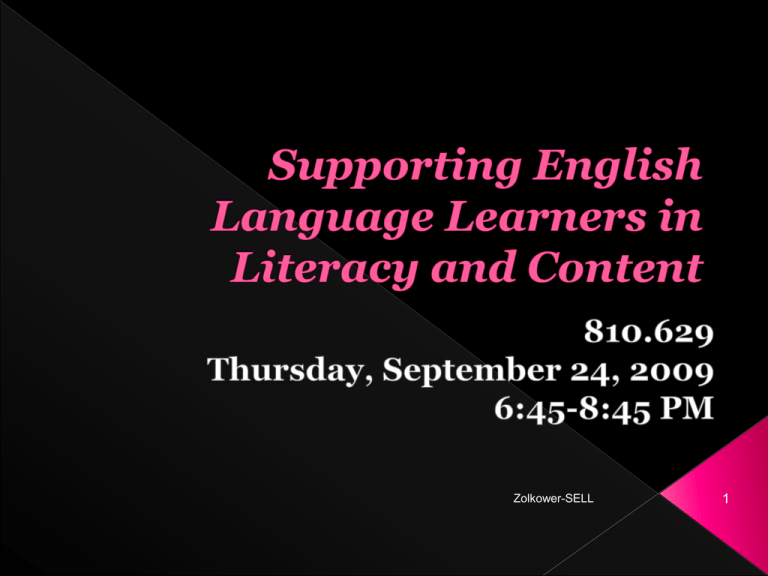
Zolkower-SELL 1 By the end of today’s class, you will be able to: Describe the connection between language, culture and identity. Articulate the difference between bottom-up and top-down processing in reading. Identify effective strategies for teaching reading in a second language context. Identify components of the ESOL Praxis II exam. Zolkower-SELL 2 Identity Papers Reading Instruction Writing Instruction Praxis II Zolkower-SELL 3 Find the people who have the same flag as you. You will each have 5 minutes to speak without interruption After you speak, your teammates will have 5 minutes to ask you questions or to comment. Zolkower-SELL 4 Identify the subject of your paper. Explain your rationale for choosing that person as your subject. Make the connection, for your teammates, between learning a second language and your subject’s sense of identity. Articulate, as well, your belief as to the extent of the role of culture/cultural differences in acquiring the second language. 5 Zolkower-SELL Bottom-up: Data Driven: Decoding skills, such as letters & words Top-up: Conceptually driven: Comprehension skills Zolkower-SELL 6 Schema theory We bring meaning to what we read. Background knowledge and culture as a factor in reading comprehension. Content schemata: Our knowledge about people, the world, culture. Formal schemata: What we know about discourse structure. Zolkower-SELL 7 Non-fiction: essays, reports, articles Fiction: novels, short stories Poetry Plays Test questions Directions Forms Invitations Zolkower-SELL 8 Permanence Processing Time Distance Orthography Complexity Vocabulary Formality Zolkower-SELL 9 Before reading, students should… Participate in a verbally interactive, multisensory experience that integrates key language items and concepts from the text Experience extensive previewing activities (picture walks, predicting, a summary of what will be read) Have a set purpose for reading Restate purpose to ensure comprehension 2003 Division of ESOL/Bilingual Programs: ESOL Instructional Team Zolkower-SELL 10 During reading, students should… Listen to text through read-aloud or shared reading. Revisit the text (shared reading, paired reading). Break reading into chunks and summarize or retell parts as they read. Respond to questions adapted to students’ proficiency levels. 2003 Division of ESOL/Bilingual Programs: ESOL Instructional Team Zolkower-SELL 11 After reading, students should… Orally retell or summarize what was read. Revisit key vocabulary—identify new words and practice words, IN CONTEXT. Participate in a choral reading of selected passages, adding gestures or movement, when appropriate. Use LEA (language experience approach) to create an adaptable, readable, text. 2003 Division of ESOL/Bilingual Programs: ESOL Instructional Team Zolkower-SELL 12 What type of text is it? What kind of processing did you use to read it (Top-down? Bottom-up?)? Identify examples of one or both types of processing you used? What strategies would you use to teach students to read this kind of text? Zolkower-SELL 13 Study topics: Analysis of Student Language Production Linguistic Theory Teaching Methods and Techniques Assessment Techniques and Cultural Issues Professional Issues Zolkower-SELL 14 Oral Grammar and Vocabulary Pronunciation Writing Be familiar with: Comparative structures Code switching Phonetic Alphabet http://www.antimoon.com/how/pronuncsoundsipa.htm Register Zolkower-SELL 15 Phonology Morphology Syntax Psycholinguistics Sociolinguistics Zolkower-SELL 16 Which sounds in English that are typically problematic for speakers of various native languages? What kinds of words most frequently occur in a reduced form in natural speech? Intonation and stress patterns in English Types of activities that can help ESOL students monitor and improve their proficiency in English pronunciation. Zolkower-SELL 17 How do morphemes combine to create words in English? What is a digraph? How would knowing prefixes and suffixes improve a student’s ability to gain meaning from new words? Similarities and differences between syntactic systems of English and other languages. Zolkower-SELL 18 Formation of declarative and interrogative sentences in English? Identify the parts of speech, understand the English verb system and analyze student errors. Be familiar with idioms and nonliteral expressions . How can they affect an ESOL student’s understanding of spoken and written English? Zolkower-SELL 19 Grammatical transformations and structural changes and how they affect meaning Be familiar with: Krashen Cummins (BICS/CALP) Vygotsky (zone of proximal development)/Krashen (I + 1) Zolkower-SELL 20 Be familiar with: Language interference Interlanguage Code-switching Order of acquisition Affective filter Communicative competence Proxemics Zolkower-SELL 21 For Next Time Garcia: Chapter 12 Second Journal Entry due 10/4: Visualize two students; map them along a proficiency line for each skill. How do you plan and teach for the varied proficiency levels & needs of each student? Zolkower-SELL 22
